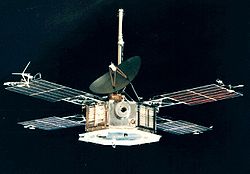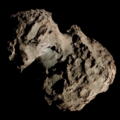7P/Pons–Winnecke
 Comet Pons–Winnecke as seen in 2021 by ZTF | |
| Discovery | |
|---|---|
| Discovered by | Jean Louis Pons Friedrich Winnecke |
| Discovery site | Marseille, France Bonn, Germany |
| Discovery date | 12 June 1819 9 March 1858 |
| Designations | |
| |
| |
| Orbital characteristics[3][4] | |
| Epoch | 25 February 2023 (JD 2460000.5) |
| Observation arc | 130.22 years |
| Number of observations | 1,797 |
| Aphelion | 5.587 AU |
| Perihelion | 1.233 AU |
| Semi-major axis | 3.410 AU |
| Eccentricity | 0.63853 |
| Orbital period | 6.296 years |
| Inclination | 22.373° |
| 93.327° | |
| Argument of periapsis | 172.54° |
| Mean anomaly | 100.03° |
| Last perihelion | 27 May 2021 |
| Next perihelion | 25 August 2027[1][2] |
| TJupiter | 2.677 |
| Earth MOID | 0.226 AU |
| Jupiter MOID | 0.273 AU |
| Physical characteristics[3][5] | |
| Dimensions | 5.2 km (3.2 mi) |
| 6.8–9.5 hours | |
| 0.04 (assumed) | |
| (V–R) = 0.40±0.05 (R–I) = 0.41±0.06 | |
| Comet total magnitude (M1) | 16.0 |
7P/Pons–Winnecke (also known as Comet Pons–Winnecke) is a periodic Jupiter-family comet with a six-year orbit around the Sun.
Observational history
Jean Louis Pons (Marseille) originally discovered the comet on 12 June 1819, it was later rediscovered by Friedrich Winnecke (Bonn) on 9 March 1858. It is the parent body of the June Bootids of late June.

Early calculations for the 1921 apparition suggested that the orbit of the comet might collide with Earth in June, but observations on 10 April ruled out an impact.[6] It made a very close approach to Earth in June 1927.[7] The outward migration of perihelion created impressive meteor showers in 1916, 1921 and 1927.[8]
Orbit
7P currently has an orbital period of 6.3 years. It currently has a perihelion of 1.2 AU (outside the orbit of Earth) and an aphelion of 5.6 AU (past the orbit of Jupiter). It passed within 0.04 AU (6.0 million km) of Earth in June 1927, and 0.1 AU (15 million km) in 1939;[3] but it will not come as close in the 21st century. A close approach to Jupiter in July 2037[3] will drop perihelion to 0.982 AU, and by 2062 perihelion will be further reduced to 0.85 AU.[2]
| Date & time of closest approach |
Earth distance (AU) |
Sun distance (AU) |
Velocity wrt Earth (km/s) |
Velocity wrt Sun (km/s) |
Uncertainty region (3-sigma) |
Reference |
|---|---|---|---|---|---|---|
| 2062-Jun-12 18:25 ± 10 min | 0.1676 AU (25.07 million km; 15.58 million mi; 65.2 LD) | 0.8499 AU (127.14 million km; 79.00 million mi; 330.8 LD) | 16.3 | 42.5 | ± 312 km | Horizons |
The next perihelion passage is 25 August 2027[1] when the comet will have a solar elongation of 63 degrees. The last perihelion passage was 27 May 2021 when the comet had a solar elongation of 107 degrees at approximately apparent magnitude 11.[9] It passed 0.44 AU (66 million km) from Earth on 12 June 2021. Before that it came to perihelion on 30 January 2015[9] with a solar elongation of 24 degrees.[4]
Physical characteristics
| Perihelion distance at different epochs[2] | |||||||
| Epoch | Perihelion (AU) | ||||||
|---|---|---|---|---|---|---|---|
| 1819 | 0.77 | ||||||
| 1875 | 0.83 | ||||||
| 1886 | 0.89 | ||||||
| 1898 | 0.92 | ||||||
| 1909 | 0.97 | ||||||
| 1921 | 1.04 | ||||||
| 1933 | 1.10 | ||||||
| 1989 | 1.26 | ||||||
| 2027 | 1.13 | ||||||
| 2039 | 0.982 | ||||||
| 2062 | 0.847 | ||||||
The comet nucleus is estimated to be 5.2 km (3.2 mi) in diameter.[3] Photometric measurements from the European Southern Observatory (ESO) reveals that the comet exhibited brightness variations, which imply that its rotation period is roughly between 6.8–9.5 hours.[5] Dust production rate was measured to be less than 150 kg/s (330 lb/s) during its 2021 apparition.[10]
Proposed exploration

The Jet Propulsion Laboratory proposed a flyby of the comet with a flight spare of Mariner 4 with the closest approach taking place in 1969 at a distance of 5,000 km (3,100 mi).[11] However, the intrinsically faint comet's ephemeris was poorly defined at the time, making it difficult to track its position optically from the ground.[11] The probe was instead used for a 1967 Venus flyby as Mariner 5.[11]
References
- ^ a b "Horizons Batch for 7P/Pons-Winnecke (90000167) on 2027-Aug-25" (Perihelion occurs when rdot flips from negative to positive). JPL Horizons. Retrieved 15 June 2022. (JPL#24/Soln.date: 2021-Dec-20)
- ^ a b c Kinoshita, Kazuo (31 July 2016). "7P/Pons-Winnecke past, present and future orbital elements". Comet Orbit. Archived from the original on 20 May 2011. Retrieved 27 July 2023.
- ^ a b c d e f "7P/Pons-Winnecke – JPL Small-Body Database Lookup". ssd.jpl.nasa.gov. Jet Propulsion Laboratory. Retrieved 25 February 2010.
- ^ a b "7P/Pons-Winnecke Orbit". Minor Planet Center. Retrieved 5 March 2019.
- ^ a b C. Snodgrass; A. Fitzsimmons; S. C. Lowry (2005). "The nuclei of comets 7P/Pons-Winnecke, 14P/Wolf and 92P/Sanguin" (PDF). Astronomy & Astrophysics. 444 (1): 287–295. arXiv:astro-ph/0509115v1. Bibcode:2005A&A...444..287S. doi:10.1051/0004-6361:20053237. S2CID 119473563.
- ^ a b "The Pons–Winnecke Comet Will Almost Hit the Earth". Popular Science. July 1921. p. 17.
- ^ G. W. Kronk. "Record Close Comet Distances from Earth". Cometography.com. Retrieved 2 May 2025.
- ^ G. W. Kronk. "7P/Pons-Winnecke". Cometography.com. Retrieved 5 March 2019.
- ^ a b Seiichi Yoshida (14 December 2013). "7P/Pons-Winnecke". Seiichi Yoshida's Comet Catalog. Retrieved 29 October 2014.
- ^ A. O. Novichonok; A. A. Shmal'ts; S. V. Nazarov; A. S. Pozanenko; et al. (2024). "The Evolutionary State of Near-Earth Comet 7P/Pons–Winnecke". Solar System Research. 58 (4): 456–468. Bibcode:2024SoSyR..58..456N. doi:10.1134/S003809462470028X.
- ^ a b c P. Ulivi; D. M. Harland (2007). Robotic Exploration of the Solar System Part I: The Golden Age 1957–1982. Springer. pp. 57–58. ISBN 978-0-387-49326-8.
External links
- 7P/Pons–Winnecke at the JPL Small-Body Database
- Elements and Ephemeris for 7P/Pons-Winnecke – Minor Planet Center
- 7P/Pons-Winnecke – Seiichi Yoshida @ aerith.net


